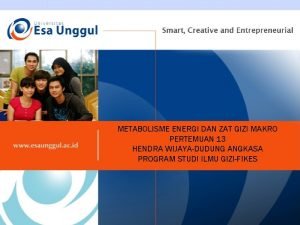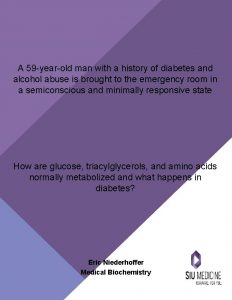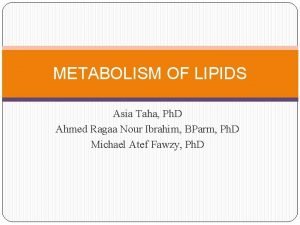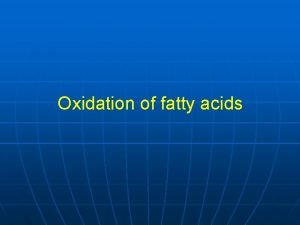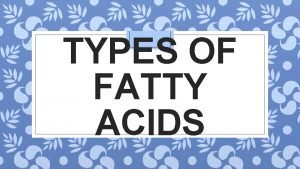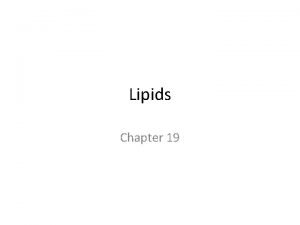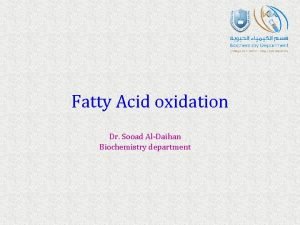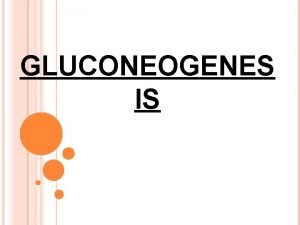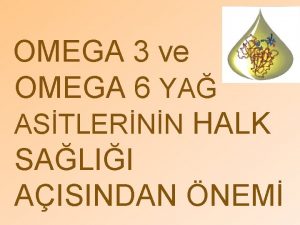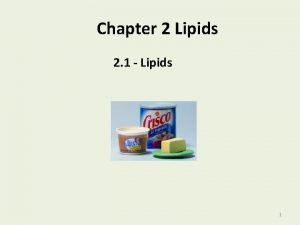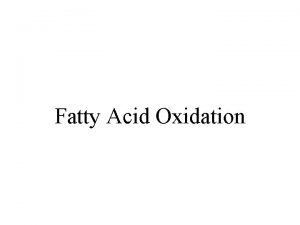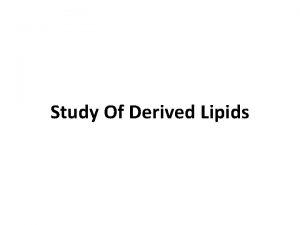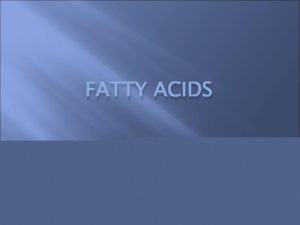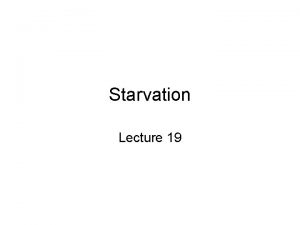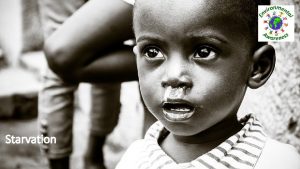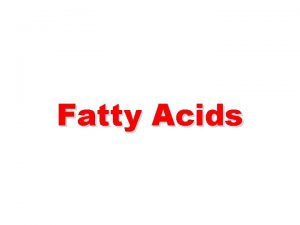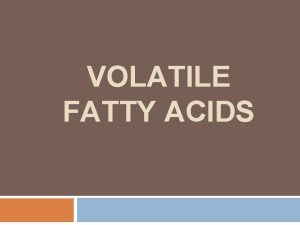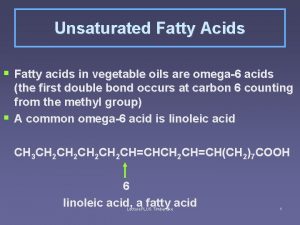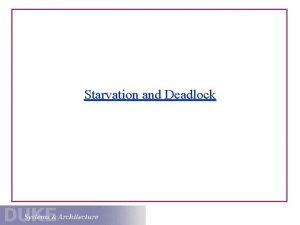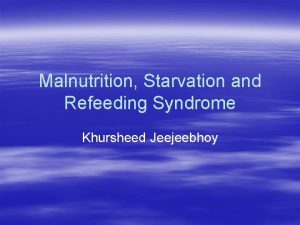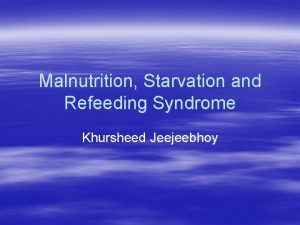Starvation Lecture 20 Lipolysis FAT Fatty acids P














- Slides: 14

Starvation Lecture 20

Lipolysis FAT Fatty acids P inactive PKA TGL/HSL Triacylglycerol lipase Hormone Sensitive Lipase Glycerol

Lipolysis • c. AMP lipolysis since c. AMP activates PKA • Glucagon lipolysis since glucagon causes an increase in c. AMP – However, this is not the main cause of the increase in c. AMP • The main cause of the increase of c. AMP is the decrease in the rate of c. AMP breakdown – Because of the decrease in phosphodiesterase activity

Fatty acid oxidation • Lipolysis releases FAs into the blood • Note, even in starvation, GLUT-1 is still present in muscle – Even though a lack of insulin has led to GLUT-4 s being endocytosed – So muscle is responsible for much glucose uptake • Need to preserve glucose: – Get tissues to stop using glucose, and use FAs instead – FAs will be oxidised to provide the acetyl Co. A for the Krebs Cycle – But need to avoid oxidation of glucose, which is an irreversible reaction

PDH • PDH = pyruvate dehydrogenase

Glucose-Fatty Acid Cycle • In starvation we want PDH to be off – PDH kinase >> PDH phosphatase – PDH kinase is stimulated by acetyl-Co. A – PDH is inactive when phosphorylated – Prevents wasteful oxidation of pyruvate – Pyruvate only made into lactate • FA released from WAT (from lipolysis), causes [FA]blood to increase and the uptake of FA into the muscle is also increased • Oxidation of FA (b-oxidation) switches PDH off by producing a lot of acetyl Co. A. This stop glucose oxidation

When PDH is off… • Pyruvate cannot be oxidized to acetyl Co. A – Then there is only one fate for pyruvate in the muscle, --- to be converted into lactate by LDH • LDH = lactate dehydrogenase • Lactate can be taken up by the liver – Made into glucose by gluconeogenesis • Glucose recycling (glucose conservation) – Cori-cycle – Muscle Glucose Pyruvate lactate liver glucose (via gluconeogenesis) glucose to the bloodstream again • Gluconeogenesis can also happen from glycerol – Up to 30 g glucose per day can be made from glycerol

In Early Starvation…

Glucose Accounting • Glycerol (from lipolysis) is the only souce of DE NOVO gluconeogenesis – The lactate fuelled gluconeogenesis is just recycling – ~30 g glucose from glycerol per day • But the brain needs ~120 g/day, – not enough! – can brain glucose consumption be reduced?

Lipolysis & b-Oxidation • After ~2 -3 days of starvation, the rate of lipolysis approaches a maximum – FA released into bloodstream [FA]blood – There is a limit to how fast muscles will use FA • rate of b-oxidation depends on the demand of ATP by the muscles • Regeneration of Co. A by Krebs cycle needed to keep FA oxidation going • BUT liver can do b-oxidation on FA even if there is no need for ATP – In the liver, Co. A can be regenerated in a pathway other than the Krebs cycle

Ketone Bodies • Ketone bodies – typically acetoacetate – Can be taken up & oxidised by the brain – Where they are split to 2 x acetyl Co. A molecules – Tissues have to have mitochondria in order to use ketone bodies • Ketone bodies reduce brain glucose use from 120 g/day to 30 g/day – all 30 g could be provided by glycerol…. • …. If it wasn’t for the use of glucose by the other carbohydrate-hungry tissues like skin, etc.

Proteolysis • Hypoinsulinemia – Occurs when insulin level is really low • Especially for a long period (>48 h) • Proteins start to breakdown – PROTEOLYSIS • Gives rise to amino acids • Channeled to the liver for gluconeogenesis – Not all amino acids can be made into glucose • Glucogenic - can be made into glucose • Ketogenic - cannot be made into glucose – ~3 g protein 1 g glucose

Ketosis and amino acid use

Extended Starvation • After 2 -3 days of starvation – Losses are 50 -100 g protein/day – Even though ketone bodies inhibit proteolysis and prevent protein being lost too rapidly • Proteins are lost from all tissues – Although inactive muscles tend to slightly preferentially degraded – From heart, liver, brain, etc, as well may cause severe damage to body • Will reach equilibrium – where the amount of protein breakdown = the amount of glucose needed • But the loss of body protein is ultimately what kills us
 Fed state
Fed state Lipogenesis and lipolysis
Lipogenesis and lipolysis Lipolysis meaning
Lipolysis meaning Essential non essential fatty acids
Essential non essential fatty acids Activation of fatty acids
Activation of fatty acids Importance of lipids
Importance of lipids Esansiyel yağ asitleri
Esansiyel yağ asitleri Types of fatty acids
Types of fatty acids Properties of fatty acids slideshare
Properties of fatty acids slideshare Beta oxidation
Beta oxidation Glucogenic amino acid
Glucogenic amino acid Esansiyel yağ asitleri
Esansiyel yağ asitleri Triacylglycerols
Triacylglycerols Saturated fatty acid definition
Saturated fatty acid definition Fatty acid structure
Fatty acid structure
